
Table of Contents
Scientific Classification
- Kingdom: Animalia
- Phylum: Chordata
- Class: Reptilia
- Order: Squamata
- Family: Dactyloidae
- Genus: Anolis
- Species: A. carolinensis
Quick Overview
The Green Anole (Anolis carolinensis), often referred to as the American chameleon due to its color-changing abilities, is a small tree-dwelling lizard native to the southeastern United States. While not true chameleons, these agile lizards are still a spectacle in their own right.
Fast Facts
- Scientific Name: “Anolis carolinensis”
- Lifespan: 4-7 years in captivity, around 5 years in the wild
- Average Size: 5-8 inches in length (including tail)
- Diet: Insectivorous
- Habitat: Woodlands, urban areas, and backyards
Did you know?
While they can’t change colors as drastically as a true chameleon, Green Anoles can shift between green and brown, often reflecting their mood, health, and environmental factors.
Appearance
Males typically sport a vibrant green coloration, while females can be more variable, showing shades of brown and green. Males also have a distinctive pink throat fan, known as a dewlap, which they extend during territorial displays and courtship rituals.
Size and Weight
Green Anoles are slender lizards, with adults ranging from 5 to 8 inches in total length, most of which is their tail. They are lightweight, often weighing only a few grams.
Temperament and Behavior
Generally shy and reclusive, Green Anoles can become accustomed to human presence over time. In their natural habitat, they are territorial and will engage in visual displays to ward off rivals.
Fun Fact:
The male Green Anole’s courtship involves head bobbing, extending its dewlap, and performing “push-ups” to impress females.
Habitat and Distribution
Native to the southeastern parts of the United States, their habitat ranges from woodlands to shrubs in urban settings. They are often found clinging to branches, fences, or walls.
Care Guide
For those interested in keeping Green Anoles:
- A vertically oriented terrarium to mimic their tree-dwelling nature.
- Temperatures should be between 75-80°F with a basking area around 85-90°F.
- They need high humidity, so regular misting is essential.
- Provide a varied diet of small insects.
- UVB lighting is crucial for their health.
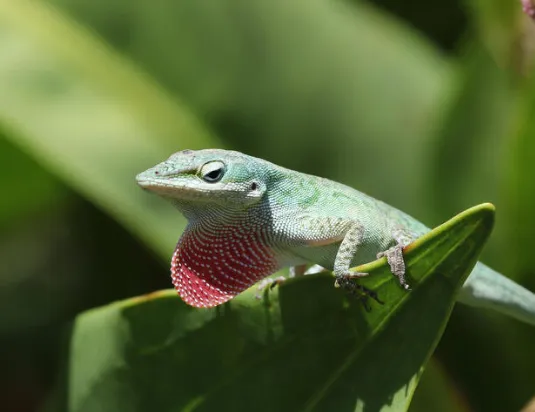
Diet and Nutrition
Primarily insectivores, their diet in the wild consists of spiders, crickets, and other small invertebrates. In captivity, they thrive on a diet of crickets, fruit flies, and the occasional mealworm.
Health and Wellness
Green Anoles are susceptible to Metabolic Bone Disease if not provided with adequate UVB lighting. Other concerns can include dehydration and respiratory infections. Proper care and a clean environment can prevent most health issues.
Breeding
After a mating dance involving the male showing off his dewlap, the female will lay her eggs in moist soil or leaf litter. She can lay several clutches per season, each containing one to two eggs.
Conservation Status
While they are not endangered, habitat loss and competition from invasive species like the Brown Anole have impacted their populations.
Fun Fact:
Despite their delicate appearance, Green Anoles can drop and regrow their tail as a defense mechanism against predators.
Photo Gallery
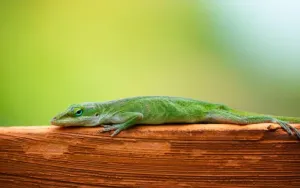
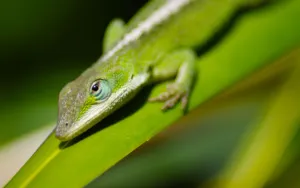
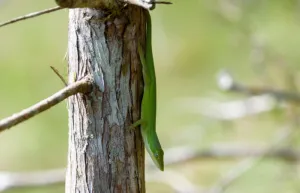
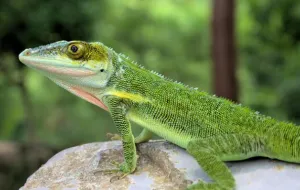
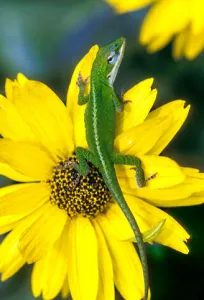
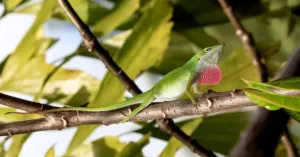
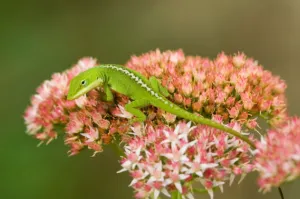
Check out the video below on how Green Anoles display their dewlaps when they’re territorial:
Related Profiles
- Brown Anole
- Knight Anole
Share This Profile:
3 Amazing Facts About Green Anole
- Solar Chargers: Green Anoles are diurnal and often seen basking in the sun, absorbing UV rays which aid in vitamin D synthesis, crucial for their health.
- Sticky Feet: Their toes are equipped with adhesive pads, allowing them to effortlessly move on smooth vertical surfaces, and even upside down.
- Solitary Nature: Green Anoles are typically solitary animals, and when housed together, especially two males, they can become territorial and aggressive towards one another.
- Enchi Ball Python: A Unique and Stunning Morph of Python regius - March 27, 2025
- Emerald Tree Monitor: The Enigmatic Green Guardian of the Rainforest - March 26, 2025
- The Egyptian Cobra (Naja haje): A Fascinating Serpent - March 25, 2025
